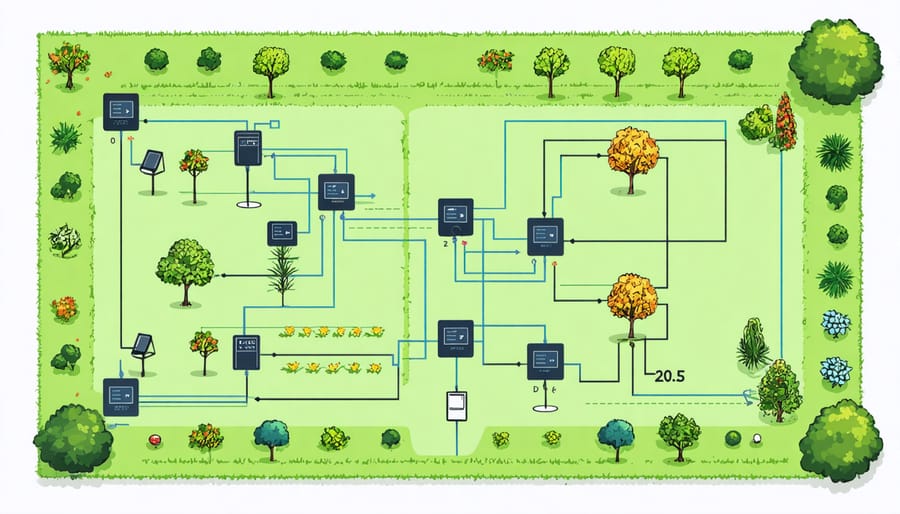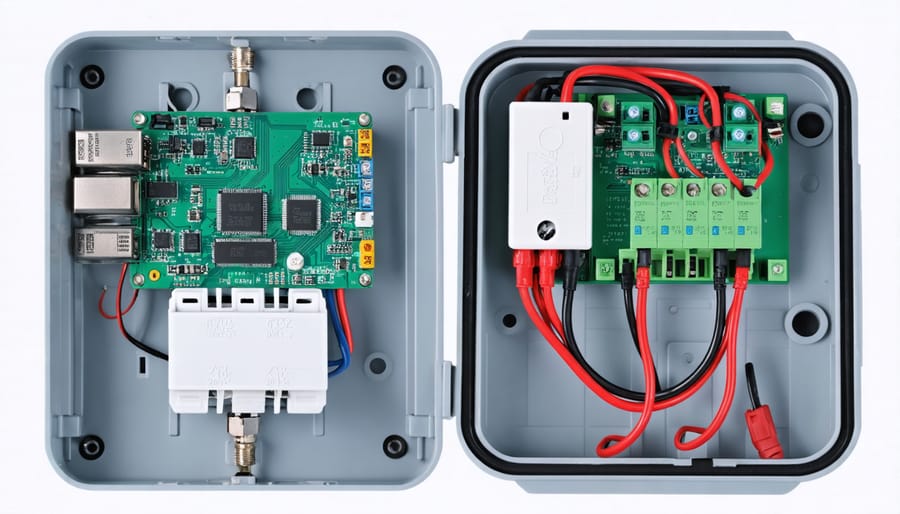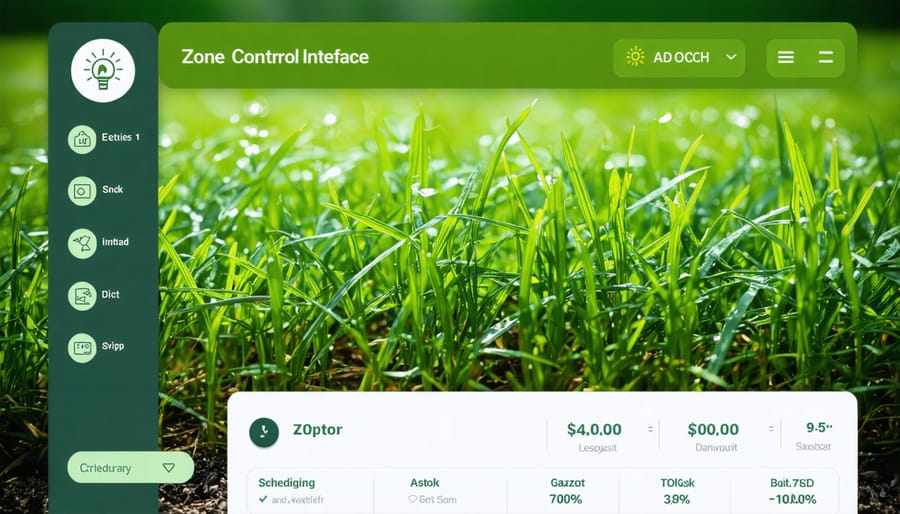Transform your garden into an automated oasis with a Zigbee irrigation controller – the smart solution that puts precise watering control at your fingertips. As a cornerstone of modern smart irrigation control systems, these wireless controllers integrate seamlessly with your existing home automation setup, offering schedule flexibility and water conservation that traditional timers simply can’t match.
Imagine adjusting your watering schedule from your smartphone while monitoring real-time soil moisture levels, or having your system automatically skip watering when rain is forecast. That’s the power of Zigbee technology – a reliable, low-power wireless protocol that’s revolutionizing how we maintain our gardens and lawns.
Whether you’re a tech-savvy homeowner looking to upgrade your irrigation system or a gardening enthusiast wanting to maximize efficiency, a Zigbee irrigation controller offers the perfect blend of convenience and sophisticated control. With features like zone-specific scheduling, weather-based adjustments, and compatibility with popular smart home platforms, these devices aren’t just changing how we water – they’re transforming the entire landscape of home garden management.
Why Zigbee Technology Powers Smart Irrigation
The Mesh Network Advantage
One of the coolest features of Zigbee irrigation controllers is their mesh networking capability, which acts like a digital relay team in your yard. Instead of every device needing to communicate directly with the hub, each Zigbee device can pass signals along to its neighbors. This creates a web-like network where signals can find multiple paths to reach their destination.
Think of it like a game of telephone, but one that actually works perfectly! When you have multiple Zigbee devices in your yard, each one serves as a signal booster, extending the network’s range far beyond what a single connection could achieve. This is especially helpful in larger yards or gardens where distance might otherwise be an issue.
The mesh network also provides built-in backup routes. If one device stops working or encounters interference, the network automatically finds another path to keep your irrigation system running smoothly. This self-healing feature means more reliable performance and fewer connectivity headaches for you.
Plus, as you add more Zigbee devices to your yard, your network actually becomes stronger and more reliable, creating a robust system that grows with your needs.

Low Power, High Performance
One of the most impressive features of Zigbee irrigation controllers is their remarkable energy efficiency. These smart devices are designed to operate on minimal power while delivering optimal performance. Most Zigbee controllers can run for months or even years on a single set of batteries, making them perfect for outdoor installation where power outlets might be scarce.
The secret lies in Zigbee’s low-power mesh networking technology, which allows devices to communicate efficiently while consuming tiny amounts of energy. When your controller isn’t actively sending commands or receiving updates, it enters a sleep mode that dramatically reduces power consumption. This smart power management doesn’t compromise functionality – your irrigation schedules and automated routines continue to run seamlessly.
For homeowners, this means less maintenance, lower operating costs, and enhanced reliability. You won’t need to worry about frequent battery changes or running electrical lines to your garden. Plus, the mesh network’s ability to relay signals through multiple devices ensures strong connectivity throughout your yard, even in larger properties.
Setting Up Your Zigbee Irrigation Controller

Hardware Installation
Installing your Zigbee irrigation controller is a straightforward process that you can complete in about 30 minutes. Start by choosing a suitable location near your existing irrigation system’s main valve, ensuring it’s protected from direct exposure to rain and sunlight. The spot should also be within range of your Zigbee hub – typically within 30-50 feet indoors.
Before mounting, turn off the main water supply and electrical power to your existing irrigation system. Mount the controller’s weatherproof housing on a wall or flat surface using the included screws and anchors. Make sure it’s at a comfortable height for easy access and maintenance.
Connect the controller to your irrigation system’s solenoid valves using the labeled wire terminals. Most controllers support 4-8 zones, with clearly marked connections for each. If your current system uses 24V AC solenoids, they’ll be compatible with most Zigbee controllers.
Power up the controller using either the included power adapter or hardwiring it to your existing 24V AC transformer. Once powered, the controller’s LED indicator should light up, showing it’s ready for network connection.
Pro tip: Take photos of your existing wiring setup before disconnecting anything – this will make it much easier to troubleshoot if needed. Also, consider installing a surge protector to safeguard your controller during electrical storms.
Network Integration
One of the biggest advantages of a Zigbee irrigation controller is its seamless integration with your existing smart home ecosystem. Whether you’re using Samsung SmartThings, Amazon Alexa, or other popular smart home hubs, these controllers fit right into your network of garden automation solutions. The setup process is straightforward: once powered on, your controller will automatically search for nearby Zigbee networks. Simply put your hub in pairing mode, and within minutes, your irrigation controller will join your home network.
This integration opens up exciting possibilities for automation. You can create schedules that work in harmony with other smart devices, like having your sprinklers adjust based on readings from your weather station or soil moisture sensors. Voice control becomes a reality too – imagine saying “Alexa, water the garden for 10 minutes” on those extra-hot days.
The network also enables remote monitoring and control through your smartphone. Whether you’re on vacation or just at work, you can check your system’s status, adjust watering schedules, or respond to weather changes. Plus, many controllers support automated alerts, notifying you about important events like successful watering cycles or potential system issues.
For optimal performance, position your controller within reasonable range of your Zigbee hub or network repeater. This ensures stable connectivity and responsive control of your irrigation system.

Smart Features That Save Time and Water
Weather-Based Scheduling
One of the most impressive features of Zigbee irrigation controllers is their ability to adapt watering schedules based on real-time weather conditions. These smart devices connect to local weather stations or online weather services to gather data about rainfall, temperature, humidity, and wind speed. By analyzing this information, the controller makes intelligent decisions about when and how much to water your garden.
For example, if rain is forecasted, the system will automatically skip scheduled watering cycles, preventing overwatering and implementing water-saving irrigation features that help reduce waste. On particularly hot days, it might increase watering duration to compensate for increased evaporation.
The controller also considers seasonal changes, adjusting watering patterns throughout the year. During spring, when plants need more water for growth, the system increases water delivery. In fall, as temperatures drop and plants require less moisture, it automatically reduces watering frequency.
This smart weather-based scheduling not only promotes healthier plant growth but also helps conserve water and reduce your utility bills. You can typically override these automatic adjustments through your smartphone app if you need to make manual changes for specific garden needs.
Zone Control and Scheduling
One of the most powerful features of Zigbee irrigation controllers is their ability to manage multiple garden zones with precision. By dividing your yard into distinct watering zones, you can ensure each area receives exactly the right amount of water based on its specific needs. These automated watering systems let you create custom schedules for each zone, taking into account factors like plant types, sun exposure, and soil conditions.
Setting up zones is straightforward: simply assign your sprinklers or drip lines to different controller outputs, then use the smartphone app to name and configure each zone. You might label them as “vegetable garden,” “front lawn,” or “flower beds” for easy reference. The scheduling options are incredibly flexible, allowing you to set different watering durations, frequencies, and start times for each zone.
Want to water your vegetables daily but your drought-resistant plants just once a week? No problem! You can even integrate weather data to automatically adjust watering schedules based on rainfall forecasts or recent precipitation. This smart approach not only keeps your plants healthy but also helps conserve water by preventing overwatering in certain areas while ensuring others get enough moisture.
Common Challenges and Solutions
Signal Issues
Like any wireless device, Zigbee irrigation controllers can sometimes face connectivity challenges. The good news is that most signal issues are easily fixable. If your controller loses connection, start by checking its distance from your Zigbee hub – ideally, they should be within 30-50 feet of each other. Walls, especially metal ones, and large appliances can interfere with the signal, so consider repositioning either the hub or controller for better reception.
Another common solution is to add a Zigbee repeater or smart plug between your hub and controller. These devices strengthen the signal by creating a mesh network, ensuring stable connectivity even in larger homes. If you’re experiencing intermittent connection drops, check for potential interference from other wireless devices operating on similar frequencies, like microwaves or cordless phones.
Regular firmware updates are essential for maintaining strong connectivity. Make sure both your hub and controller are running the latest software versions. If problems persist, try resetting your controller and re-pairing it with your hub – this often resolves stubborn connection issues.
System Maintenance
To keep your Zigbee irrigation controller running smoothly, establish a regular maintenance routine throughout the year. Every month, check the connection status of your controller in your smart home app and ensure all zones are responding correctly. Clean the controller’s exterior with a slightly damp cloth to remove dust and debris, being careful not to let moisture seep into the device.
As seasons change, adjust your watering schedules accordingly. In spring, gradually increase watering frequency as temperatures rise. During summer, consider programming earlier morning or late evening watering times to minimize evaporation. Scale back watering in fall, and in winter, adjust or pause schedules depending on your climate.
Replace the backup batteries annually, even if they haven’t died, to ensure uninterrupted operation during power outages. Check valve connections and wiring every six months for signs of wear or damage. If you live in an area with frequent power fluctuations, consider installing a surge protector to safeguard your controller.
Remember to update your controller’s firmware whenever new versions become available to ensure optimal performance and security.
Compatibility and Integration
One of the best things about Zigbee irrigation controllers is their excellent compatibility with various smart home ecosystems. Most models work seamlessly with popular platforms like Samsung SmartThings, Amazon Alexa, and Apple HomeKit, letting you control your irrigation system through your preferred smart home hub or voice assistant.
These controllers typically integrate well with other Zigbee devices in your home network, creating a mesh network that strengthens connectivity throughout your property. You can easily expand your system by adding moisture sensors, rain sensors, or additional valve controllers without worrying about compatibility issues.
For those who love to customize their setup, many Zigbee irrigation controllers offer open API access, allowing you to create custom automation scripts or integrate with third-party applications. This flexibility means you can set up complex watering schedules based on multiple factors like weather forecasts, soil moisture levels, and even your local water restrictions.
When it comes to physical compatibility, most controllers work with standard 24V AC irrigation valves, making them suitable replacements for traditional irrigation timers. Many models also offer expansion modules that let you add more zones to your system as your garden grows.
For the tech-savvy gardener, some controllers can integrate with popular home automation platforms like Home Assistant or OpenHAB, providing even more customization options. Just remember to check the specific compatibility requirements of your chosen controller before purchase, as some features may require additional hardware or subscriptions to work properly.
Remember, while these controllers offer extensive compatibility options, starting simple and expanding your system gradually is often the best approach for most homeowners.
Implementing a Zigbee irrigation controller in your home is more than just a tech upgrade – it’s a smart investment in your property’s future. By adopting this innovative solution, you’ll save time and water while maintaining a healthier, more vibrant landscape. The convenience of controlling your irrigation system from your smartphone, combined with the reliability of Zigbee’s mesh network, makes garden maintenance simpler and more efficient than ever before.
The benefits extend beyond just convenience. With features like weather-based scheduling and real-time monitoring, you’ll significantly reduce water waste and potentially save money on your utility bills. The system’s ability to integrate with other smart home devices creates a truly automated living environment that works seamlessly around your lifestyle.
Whether you’re a tech enthusiast or simply looking for a more efficient way to manage your garden, a Zigbee irrigation controller offers the perfect balance of functionality and user-friendliness. The initial setup might require some patience, but the long-term advantages far outweigh the learning curve.
Ready to transform your irrigation system? Take the first step toward smarter gardening today. With the right controller and a little preparation, you’ll soon enjoy the peace of mind that comes with knowing your garden is being cared for intelligently and efficiently.
